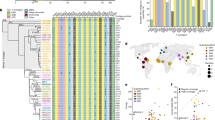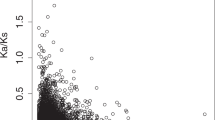Abstract
Although much structural polymorphism in the human genome has been catalogued1,2,3,4,5, the kinetics of underlying change remain largely unexplored. Because human Y chromosomes are clonally inherited, it has been possible to capture their detailed relationships in a robust, worldwide genealogical tree6,7. Examination of structural variation across this tree opens avenues for investigating rates of underlying mutations. We selected one Y chromosome from each of 47 branches of this tree and searched for large-scale variation. Four chromosomal regions showed extensive variation resulting from numerous large-scale mutations. Within the tree encompassed by the studied chromosomes, the distal-Yq heterochromatin changed length ≥12 times, the TSPY gene array changed length ≥23 times, the 3.6-Mb IR3/IR3 region changed orientation ≥12 times and the AZFc region was rearranged ≥20 times. After determining the total time spanned by all branches of this tree (∼1.3 million years or 52,000 generations), we converted these mutation counts to lower bounds on rates: ≥2.3 × 10−4, ≥4.4 × 10−4, ≥2.3 × 10−4 and ≥3.8 × 10−4 large-scale mutations per father-to-son Y transmission, respectively. Thus, high mutation rates have driven extensive structural polymorphism among human Y chromosomes. At the same time, we found limited variation in the copy number of Y-linked genes, which raises the possibility of selective constraints.
This is a preview of subscription content, access via your institution
Access options
Subscribe to this journal
Receive 12 print issues and online access
$209.00 per year
only $17.42 per issue
Buy this article
- Purchase on Springer Link
- Instant access to full article PDF
Prices may be subject to local taxes which are calculated during checkout





Similar content being viewed by others
References
Iafrate, A.J. et al. Detection of large-scale variation in the human genome. Nat. Genet. 36, 949–951 (2004).
Sebat, J. et al. Large-scale copy number polymorphism in the human genome. Science 305, 525–528 (2004).
Sharp, A.J. et al. Segmental duplications and copy-number variation in the human genome. Am. J. Hum. Genet. 77, 78–88 (2005).
Stefansson, H. et al. A common inversion under selection in Europeans. Nat. Genet. 37, 129–137 (2005).
Tuzun, E. et al. Fine-scale structural variation of the human genome. Nat. Genet. 37, 727–732 (2005).
Underhill, P.A. et al. Y chromosome sequence variation and the history of human populations. Nat. Genet. 26, 358–361 (2000).
The Y Chromosome Consortium. A nomenclature system for the tree of human Y-chromosomal binary haplogroups. Genome Res. 12, 339–348 (2002).
Vignaud, P. et al. Geology and palaeontology of the Upper Miocene Toros-Menalla hominid locality, Chad. Nature 418, 152–155 (2002).
Hughes, J.F. et al. Conservation of Y-linked genes during human evolution revealed by comparative sequencing in chimpanzee. Nature 437, 100–103 (2005).
Rozen, S. et al. Abundant gene conversion between arms of palindromes in human and ape Y chromosomes. Nature 423, 873–876 (2003).
Tyler-Smith, C., Taylor, L. & Muller, U. Structure of a hypervariable tandemly repeated DNA sequence on the short arm of the human Y chromosome. J. Mol. Biol. 203, 837–848 (1988).
Grace, H.J., Ally, F.E. & Paruk, M.A. 46,Xinv(Yp+q-) in four generations of an Indian family. J. Med. Genet. 9, 293–297 (1972).
Bernstein, R., Wadee, A., Rosendorff, J., Wessels, A. & Jenkins, T. Inverted Y chromosome polymorphism in the Gujerati Muslim Indian population of South Africa. Hum. Genet. 74, 223–229 (1986).
Repping, S. et al. Polymorphism for a 1.6-Mb deletion of the human Y chromosome persists through balance between recurrent mutation and haploid selection. Nat. Genet. 35, 247–251 (2003).
Repping, S. et al. A family of human Y chromosomes has dispersed throughout northern Eurasia despite a 1.8-Mb deletion in the azoospermia factor c region. Genomics 83, 1046–1052 (2004).
Skaletsky, H. et al. The male-specific region of the human Y chromosome is a mosaic of discrete sequence classes. Nature 423, 825–837 (2003).
Manz, E., Schnieders, F., Muller Brechlin, A. & Schmidtke, J. TSPY-related sequences represent a microheterogeneous gene family organized as constitutive elements in DYZ5 tandem repeat units on the human Y chromosome. Genomics 17, 726–731 (1993).
Affara, N.A. et al. Variable transfer of Y-specific sequences in XX males. Nucleic Acids Res. 14, 5375–5387 (1986).
Page, D.C. Sex reversal: deletion mapping the male-determining function of the human Y chromosome. Cold Spring Harb. Symp. Quant. Biol. 51, 229–235 (1986).
Tilford, C. et al. A physical map of the human Y chromosome. Nature 409, 943–945 (2001).
Kuroda-Kawaguchi, T. et al. The AZFc region of the Y chromosome features massive palindromes and uniform recurrent deletions in infertile men. Nat. Genet. 29, 279–286 (2001).
Sankoff, D. Minimal mutation trees of sequences. SIAM J. Appl. Math. 28, 35–42 (1975).
Machev, N. et al. Sequence family variant loss from the AZFc interval of the human Y chromosome, but not gene copy loss, is strongly associated with male infertility. J. Med. Genet. 41, 814–825 (2004).
de Llanos, M., Ballesca, J.L., Gazquez, C., Margarit, E. & Oliva, R. High frequency of gr/gr chromosome Y deletions in consecutive oligospermic ICSI candidates. Hum. Reprod. 20, 216–220 (2005).
Ferlin, A. et al. Association of partial AZFc region deletions with spermatogenic impairment and male infertility. J. Med. Genet. 42, 209–213 (2005).
Hucklenbroich, K. et al. Partial deletions in the AZFc region of the Y chromosome occur in men with impaired as well as normal spermatogenesis. Hum. Reprod. 20, 191–197 (2005).
Lynch, M. et al. The Y chromosome gr/gr subdeletion is associated with male infertility. Mol. Hum. Reprod. 11, 507–512 (2005).
Collins, F.S., Brooks, L.D. & Chakravarti, A.A. DNA polymorphism discovery resource for research on human genetic variation. Genome Res. 8, 1229–1231 (1998).
Schnedl, W. Flurescenzuntersuchungen ueber die langenvariabilitaet des Y-chromosoms beim menschen. Humangenetik 12, 188–194 (1971).
Saxena, R. et al. Four DAZ genes in two clusters found in the AZFc region of the human Y chromosome. Genomics 67, 256–267 (2000).
Acknowledgements
We thank G. Farino for DNA sequencing; V. Frazzoni and G. Rogers for tissue culture; N.A. Ellis, M.F. Hammer, T. Jenkins, R.D. Oates and S. Silber for cell lines and blood samples; J. de Vries, N. Leschot and P. Underhill for technical and scientific advice; J.E. Alfoldi, A.E. Baltus, D.W. Bellott, A. Chakravarti, M.J. Daly, J.F. Hughes, L. Kruglyak, Y.-H. Lim, J.L. Mueller and D.E. Reich for comments on the manuscript and A.G. Clark for advice and guidance on studies of mutation rates. This work was supported by the US National Institutes of Health, the Howard Hughes Medical Institute, the Netherlands Organization for Scientific Research and the Academic Medical Center.
Author information
Authors and Affiliations
Corresponding author
Ethics declarations
Competing interests
The authors declare no competing financial interests.
Supplementary information
Supplementary Fig. 1
Y-chromosome genealogical tree and structural polymorphisms identified, with sample identifiers and haplotype designations. (PDF 124 kb)
Supplementary Fig. 2
AZFc architectures that can be generated from the reference sequence in three or fewer homologous recombination events. (PDF 1128 kb)
Supplementary Fig. 3
Deletion at center of palindrome P3 in sample PD339. (PDF 11 kb)
Supplementary Fig. 4
Structural variant in sample YCC038. (PDF 783 kb)
Supplementary Fig. 5
Mutational event that can generate AZFc architecture c6. (PDF 168 kb)
Supplementary Fig. 6
Mutational pathway that can generate AZFc architecture c36. (PDF 178 kb)
Supplementary Fig. 7
Mutational pathways that can generate AZFc architecture c38. (PDF 354 kb)
Supplementary Fig. 8
Copy number of BPY2 and CDY1 genes. (PDF 87 kb)
Supplementary Table 1
Summary of samples and experimental results. (PDF 17 kb)
Supplementary Table 2
AZFc architectures that can be generated from the reference sequence in three or fewer homologous recombination events. (PDF 76 kb)
Rights and permissions
About this article
Cite this article
Repping, S., van Daalen, S., Brown, L. et al. High mutation rates have driven extensive structural polymorphism among human Y chromosomes. Nat Genet 38, 463–467 (2006). https://doi.org/10.1038/ng1754
Received:
Accepted:
Published:
Issue Date:
DOI: https://doi.org/10.1038/ng1754
This article is cited by
-
Characterizing the evolution and phenotypic impact of ampliconic Y chromosome regions
Nature Communications (2023)
-
Chromosomal polymorphisms have no negative effect on reproductive outcomes after IVF/ICSI-ET/FET
Scientific Reports (2022)
-
Novel Mutations of TSPY1 Gene Associate Spermatogenic Failure Among Men
Reproductive Sciences (2022)
-
Human AZFb deletions cause distinct testicular pathologies depending on their extensions in Yq11 and the Y haplogroup: new cases and review of literature
Cell & Bioscience (2021)
-
Structural and numerical Y chromosomal variations in elderly men identified through multiplex ligation-dependent probe amplification
Journal of Human Genetics (2021)



